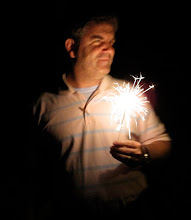 Take A Shot
Take A ShotWhen I was a freshman at Michigan, I lived across the hall in the dorm from Mike McGee, who was at the time one of the most promising high school basketball recruits in the country - even more so than Earvin "Magic" Johnson who was a freshman at Michigan State. I remember watching Mike on TV in a game at halftime, when a reporter asked him what he was going to do in the second half to secure the win, Mike said: "I'm gonna work a little on the 'O' and a little on the 'D' . . . " -- thanks for that insight Mike, back to you in the booth . . .
OK, Pick One
I read recently that research proved that people can't truly focus on two things at the same time --Multi-tasking is really working on several things in a routine that allows progress to occur simultaneously. The act of juggling actually proves this point - an accomplished juggler is only able to keep multiple objects in the air through a patten of rehearsed movements. The focus is not on the individual objects or separate movements, but on the routine. If the juggler were to focus on the shape, color or even number of objects, rather than the rhythm or 'feel' of the pattern, everything would fall to the ground.
Ouch!

Ever hit your finger trying to pound
in a nail? I can tell you, for me, it happened when it was getting dark (or the light was poor), when I should have been wearing glasses, or when I was tired.
Boo Hoo - Focus Better
Hitting a nail squarely on the head, and the rhythm of sending a 16-penny nail home in 2 swings, with a 22oz framing hammer is one of the more satisfying feelings of focus for me (and one that probably contributed to my passion for playing drums). You can force a bent nail in by adjusting the angle and speed of the hammer - which sometimes feels like bending the nail straight by pure willpower.
OK Now I Use A Nailgun
Most construction tools and equipment use ancient "Egyptian" levers, pulleys, hydraulics, etc to focus increased power or pressure on a particular task - to help make the task easier, or simpler. I am sure new tools are developed as a result of someone examining a difficult or repetitive task (routine) and asking if it could be done a different way, with a bigger lever or pulley, or with help of water, wind, etc. -- Too often, I notice that routines may start out working well, but when they lose the original focus (the "why"), they become mundane or perfunctory. This results in wasted or superfluous effort, which is the exact opposite of what the original routine was designed to do.
Continuous Improvement guru's tell us that we should constantly be looking at 4 things:
1. Purpose of the Activity
2. Available Resources (Tools, Equipment & Manpower)
3. History, Competitors and New Developments
4. Leaner Processes
And I would add:
5. Rhythm of the Activity
Basketball Again?
The first drum lesson I ever took, the teacher got me to think of hitting the drum like dribbling a basketball - striking the drumhead is important, but to get an even pattern, you need to work on the feeling of strike and bounce-back. I believe that true focus is a rhythm: Push, then pull back. Work hard on a puzzle or problem, then do something else for a few minutes and the solution comes easier. There are numerous examples of this concept - "work hard, play hard", "flex-release", "heave (then) ho", etc . . .
After all, you can't push a nail into the wood, you have to pull back and swing in a controlled motion - golf is another example (and I certainly need a lot more work on that), and there are hundreds of swing coaches who help get your game together, as long as you can keep your focus and routine simple - Pull back, swing . . . pull back, swing. Focus on the target and the rhythm of the motion.
Take A Break & Come Back 110%
It can be the same with any endeavor - if you keep it simple, with the proper routine of focus, your work will be much more satisfying, and successful.
Related Trivia:
Mike McGee and Magic Johnson both went on to play for the LA Lakers. Magic Johnson was one of the most successful, smooth-passers ever to play the game, and he was a great example of a rhythm-focused player. Mike McGee (whose notoriety will surely return after this blog) was perhaps every bit as gifted a shooter as Magic, but he did not achieve anywhere near the same level of success, perhaps because he did not have the focus he had in high school, in the pros.
Recommended Rhythm-Focus Links:
1. Steve Gadd (one of the greatest drummers of all time) demonstrating the Mozambique at a clinic - notice his focus, and ability to quickly adjust to a fast tempo with the same complicated beat: http://www.youtube.com/watch?v=UCdeKmHwK30
2. Chris Bliss performing an amazing juggling routine: http://video.google.com/videoplay?docid=4776181634656145640#
3. Michael Moschen (the father of Contact Juggling) puts on a quietly mesmerizing show of juggling in a TED presentation: http://www.ted.com/talks/michael_moschen_juggles_rhythm_and_motion.html
How to Juggle poster:

